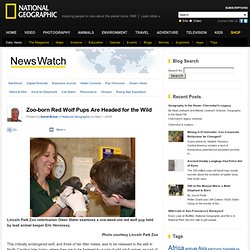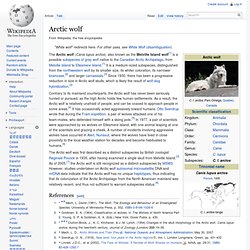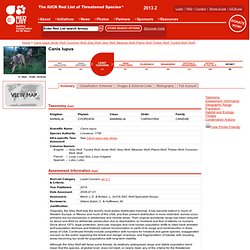

The Newfoundland Wolf is Back.
Canis lupus arctos. Mexican Grey Wolves. White Wolf : New Wolf Species Emerging in America. Wolf rebound depends on U.S.

/Canada plan A Maine conservation group wants to see wolf populations rebound in its state and said there's a good chance there are more wolves in New Brunswick that should be protected, jointly, by the U.S. and Canada. DNA tests released last week confirmed the first known wolf kill in New Brunswick since the late 1870s. John Glowa, president of the Maine Wolf Coalition, believes the animals are trying to re-establish themselves in eastern North America and said over the past 20 years, wolves have been found in Maine, Massachusetts and New York State. "It seems to be a new wolf species. "It's an extremely interesting and complex situation that scientists really haven't gotten a handle on yet.
" Glowa said based on these sightings, he predicted it was only a matter of time before one was found in neighbouring New Brunswick. He said the large meat-eaters pose very little risk to humans. "The chances of it occurring are infinitesimally small. 'It is happening.
Red Wolves. The Wolves of North America. Abstract An early attempt to delineate new subspecies of the North American gray wolf and red wolf, based on museum specimens.

Though gray wolf classification has since changed substantially, this work is still of some historical interest. The wolves of North America have remained very imperfectly known until the present time, owing no doubt to the limited material for study contained in museum collections. Wolves have become extinct over vast areas, including the eastern United States, but have persisted in some of the wilder, more remote regions, especially along the backbone of the continent.The specimens that have accumulated, largely in connection with predatory animal control, now afford a fairly satisfactory basis for determining specific and subspecific relationships....
In considering the names of North American wolves, Miller showed that Canis lycaon Schreber must stand for the animal occurring in eastern Canada. Canis lupus labradorius subsp. nov. Point Defiance Zoo & Aquarium > Red Wolf Woods. The red wolf had nearly vanished from the wild in the 1970s.

By 1980, the red wolf population was down to 14 pure wolves. These were brought to Point Defiance Zoo & Aquarium as part of the recovery program known as a Species Survival Plan (SSP), a program managed by the Association of Zoos & Aquariums. Thanks to the efforts of Point Defiance Zoo & Aquarium and other organizations, the red wolf population has grown from 14 to over 250 wolves. Red wolves have even been reintroduced to the wild and are continuing to grow in numbers to this day. Learn more about red wolves! At the Zoo Look for the wolves using exhibit and den cameras.
History & Conservation. Red Wolf. Zoo-born Red Wolf Pups Are Headed for the Wild. Lincoln Park Zoo veterinarian Owen Slater examines a one-week-old red wolf pup held by lead animal keeper Erin Hennessy.

Photo courtesy Lincoln Park Zoo. Arctic Wolf. Contrary to its mainland counterparts, the Arctic wolf has never been seriously hunted or pursued, as the high Arctic holds few human settlements.

As a result, the Arctic wolf is relatively unafraid of people, and can be coaxed to approach people in some areas.[4] It has occasionally acted aggressively toward humans. Otto Sverdrup wrote that during the Fram expidition, a pair of wolves attacked one of his team-mates, who defended himself with a skiing pole.[5] In 1977, a pair of scientists were approached by six wolves on Ellesmere Island, with one animal leaping at one of the scientists and grazing a cheek. A number of incidents involving aggressive wolves have occurred in Alert, Nunavut, where the wolves have lived in close proximity to the local weather station for decades and become habituated to humans.[6] References[edit] Canis lupus (Gray Wolf, Arctic Wolf, Common Wolf, Grey Wolf, Mexican Wolf, Plains Wolf, Timber Wolf, Tundra Wolf, Wolf) Justification: Originally, the Grey Wolf was the world's most widely distributed mammal.

It has become extinct in much of Western Europe, in Mexico and much of the USA, and their present distribution is more restricted; wolves occur primarily but not exclusively in wilderness and remote areas. Their original worldwide range has been reduced by about one-third by deliberate persecution due to depredation on livestock and fear of attacks on humans. Since about 1970, legal protection, land-use changes and rural human population shifts to cities have arrested wolf population declines and fostered natural recolonization in parts of its range and reintroduction in three areas of USA.
Continued threats include competition with humans for livestock and game species, exaggerated concern by the public regarding the threat and danger of wolves, and fragmentation of habitat, with resulting areas becoming too small for populations with long-term viability. Arctic wolf - CreationWiki, the encyclopedia of creation science. Food Habits of Arctic Wolves in Greenland. Abstract A study analyzed feces to determine the natural prey of arctic wolves (Canis lupus) in Nansen Land North Greenland and Hold with Hope East Greenland.

Muskoxen (Ovibos moschatus) is the major food of wolves in both Nansen Land and Hold with Hope. Diet of wolves (Canis lupus) in North America has been subject to intensive study. These investigations have established that wolves kill a variety of prey. Most of the diet typically consists of large ungulates such as moose (Alces alces), caribou (Rangifer tarandus), and deer (Odocoileus).
A variety of techniques has been employed to evaluate diets of wolves. Food habits of wolves at high latitudes in the Arctic have not been subject to intensive study; only a single investigation has been published...reported that 83.3% contained remains of arctic hares (Lepus arcticus) and only 16.7% contained remains of muskoxen. Field collections.
Nansen Land, North Greenland. Hold with Hope, East Greenland.